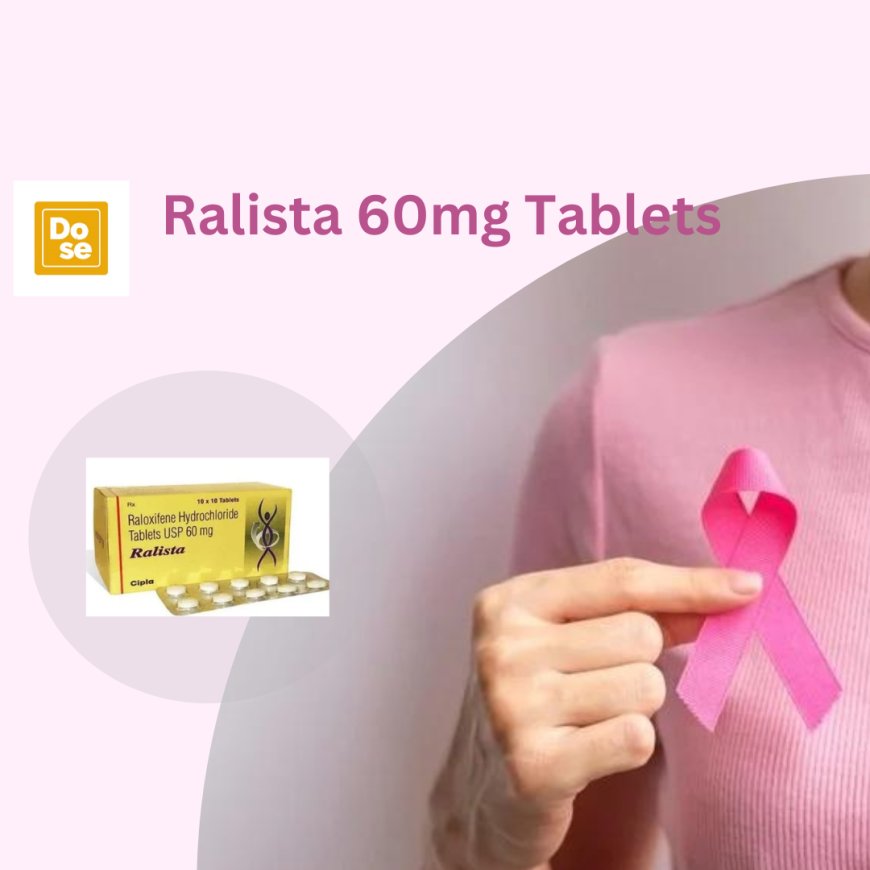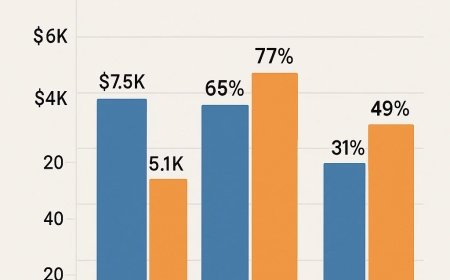Ralista 60mg Tablet: Your Ally in Fighting Breast Cancer
Among the pharmacological options available for managing this risk is Ralista 60mg Tablet. Also known as Raloxifene, Ralista is not just a medication; it is a trusted companion in the journey of preventing and managing breast cancer, particularly hormone receptor-positive types.

Breast cancer remains one of the most prevalent cancers affecting women globally. While treatment options have expanded and survival rates are improving, prevention and risk management are still crucial, especially for postmenopausal women who are at higher risk. Among the pharmacological options available for managing this risk is Ralista 60 mg. Also known as Raloxifene, Ralista is not just a medication; it is a trusted companion in the journey of preventing and managing breast cancer, particularly hormone receptor-positive types.
This article explores in detail how Ralista 60mg works, its benefits, its role in breast cancer prevention, and how it supports overall womens health.
What is Ralista 60mg Tablet?
Ralista 60mg Tablet contains Raloxifene hydrochloride, a medication classified as a Selective Estrogen Receptor Modulator (SERM). It mimics the positive effects of estrogen on bones but blocks estrogenic activity in breast and uterine tissues. This dual action makes it extremely useful in managing several postmenopausal conditions:
-
Preventing and treating osteoporosis
-
Reducing the risk of invasive breast cancer in postmenopausal women
Ralista is particularly effective in women with osteoporosis or those with a high risk of developing breast cancer due to family history, lifestyle factors, or hormone replacement therapy.
Understanding the Link Between Estrogen and Breast Cancer
Estrogen plays a critical role in the development and functioning of female reproductive organs. However, excessive or prolonged exposure to estrogeneither naturally or through medicationshas been linked to an increased risk of hormone receptor-positive breast cancers.
Breast cancer cells that are estrogen receptor-positive (ER-positive) thrive on estrogen to grow and multiply. Therefore, blocking estrogens effects in breast tissue can help reduce the likelihood of developing this type of cancer.
This is where Ralista 60mg shines. By selectively inhibiting estrogen receptors in breast tissue while maintaining beneficial estrogen effects in other areas (like bones), Ralista helps prevent cancer growth without compromising overall health.
How Ralista 60mg Tablet Works
Ralista works as a dual-action SERM, meaning it acts both as an estrogen antagonist in breast and uterine tissues and as an agonist in bone tissues.
1. Antiestrogenic Activity in Breast Tissue
Ralista binds to estrogen receptors in the breast, preventing natural estrogen from attaching. This reduces cell proliferation in breast tissue, lowering the risk of cancerous growth.
2. Estrogenic Activity in Bone Tissue
While it blocks estrogen in the breast, Ralista still maintains bone density by mimicking estrogens beneficial effects on bones. This is especially helpful for postmenopausal women, who are at increased risk for osteoporosis and related fractures.
Ralista 60mg and Breast Cancer Risk Reduction
The primary benefit of Ralista in the context of breast cancer is risk reduction. It is not a cure or direct treatment for active breast cancer, but it is highly effective inpreventing its development, particularly in high-risk women.
Clinical Studies and Efficacy
Studies such as the STAR Trial (Study of Tamoxifen and Raloxifene) demonstrated that:
-
Raloxifene (Ralista) is as effective as Tamoxifen in reducing the risk of invasive breast cancer in postmenopausal women.
-
It has fewer side effects, like uterine cancer and blood clots, compared to Tamoxifen.
For women who have a family history of breast cancer or genetic predispositions (e.g., BRCA mutations), Ralista offers a safer long-term option for risk reduction.
Who Should Use Ralista 60mg Tablet?
Ralista is most beneficial for:
-
Postmenopausal women with osteoporosis and a high risk of breast cancer
-
Women with a strong family history of breast cancer
-
Those who have taken or are avoiding hormone replacement therapy
-
Women who want a non-surgical, non-invasive option for cancer risk reduction
Note: Ralista is not suitable for premenopausal women, pregnant women, or those with a history of blood clots.
Dosage and Administration
The standard dose is one Ralista 60mg Tablet daily, with or without food. It should be taken at the same time each day to maintain consistent blood levels.
Always follow your doctors instructions. Do not stop the medication without medical advice, especially if it is part of a long-term treatment plan for osteoporosis or cancer risk reduction.
Key Benefits of Ralista 60mg Tablet
1. Breast Cancer Prevention
-
Reduces the risk ofinvasive estrogen receptor-positive breast cancer
-
Safer alternative to Tamoxifen with fewer serious side effects
2. Bone Health
-
Prevents and treats osteoporosis
-
Reduces the risk of spinal and hip fractures
3. Convenient and Non-Invasive
-
Oral medication; no injections or hospital visits
-
Can be used long-term under medical supervision
4. Dual Action
-
Supports overall postmenopausal health
-
Balances the estrogens good and harmful effects
Possible Side Effects
Like all medications, Ralista may cause side effects, though not everyone experiences them.
Common Side Effects:
-
Hot flashes
-
Leg cramps
-
Joint or muscle pain
-
Sweating
-
Nausea
Serious (Rare) Side Effects:
-
Blood clots (deep vein thrombosis or pulmonary embolism)
-
Stroke
-
Sudden vision changes (linked to blood clot complications)
Seek immediate medical help if you notice symptoms like leg swelling, chest pain, shortness of breath, or vision loss.
Precautions Before Using Ralista
Before starting Ralista 60mg, discuss the following with your doctor:
-
Personal or family history of blood clots or stroke
-
Current use of estrogen therapy
-
Any kidney or liver conditions
-
If you are immobile or on bed rest, as this increases the clot risk
-
Any planned surgeries (you may need to pause medication)
Ralista vs. Other Medications
| Medication | Class | Use | Key Difference |
|---|---|---|---|
| Ralista (Raloxifene) | SERM | Osteoporosis + Breast cancer prevention | Fewer uterine side effects |
| Tamoxifen | SERM | Breast cancer treatment and prevention | Higher risk of uterine cancer |
| Letrozole, Anastrozole | Aromatase inhibitors | Breast cancer treatment | Not for osteoporosis |
Ralista stands out for its bone protection, lower uterine risk, and postmenopausal suitability.
Buying Ralista 60mg Online
Ralista 60mg is available through prescription at most pharmacies. You can also buy Ralista 60mg online from trusted platforms like DosePharmacy, where generic and branded options are available. Always ensure:
-
The site is licensed
-
A valid prescription is uploaded
-
You receive a genuine product with a proper expiry date
Lifestyle Support Alongside Ralista
Ralista works best when combined with healthy habits:
-
A balanced diet rich in calcium and vitamin D
-
Regular weight-bearing exercises like walking or yoga
-
Avoid smoking and excessive alcohol
-
Routine breast screenings and bone density tests
These lifestyle choices further reduce cancer risk and enhance bone health.
Conclusion
Ralista 60mg Tablet is more than just a pillits a powerful partner for postmenopausal women who are looking to take control of their health. By reducing the risk of estrogen-positive breast cancer and strengthening bones, Ralista offers dual benefits in one convenient tablet.
If you're a postmenopausal woman concerned about breast cancer or osteoporosis, Ralista 60mg might be the preventive strategy you've been looking for. Always consult your healthcare provider to see if this medication aligns with your personal health goals and history.








&srotate=0)


























